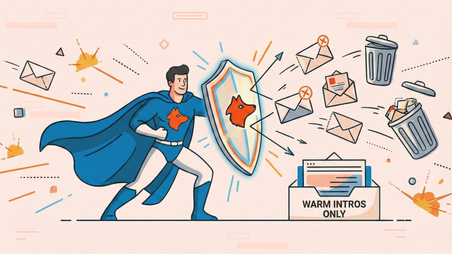Three Tactics (And Email Templates) To Land SEO Clients

Cold email is a fantastic way to land more clients for your SEO business.
Unfortunately, it’s also saturated—anyone who manages a website gets tons of cold emails from SEO-focused content marketers, link builders, and agencies.
If you’re trying to land more clients for your SEO business using cold email, you must stand out. Your emails must go beyond what everyone else is sending, or you’ll get very few replies–just like everyone else.
Lucky for you, the bar for a good SEO-related cold email is incredibly low. Most emails I get are generic and show no understanding of my SEO goals.
It’s particularly disappointing since every website is publicly available, and tons of tools like Ahrefs or Semrush surface relevant data you can use to personalize your outreach.
In this article, I share several templates you can use as inspiration when sending SEO-related cold emails. They will range from basic to advanced, depending on the depth of analysis you’ll need to conduct to send them.
My approach involves providing lots of value up front in your first email. You may think it’s not worth the effort, but in my opinion, it’s absolutely essential in a crowded niche like SEO.
I also focused on grounding my ideas in relatable data points that any website owner should understand without a deep understanding of technical SEO.
Use Ahrefs for keyword research
Many companies lack up-to-date keyword research, and the research they have is often superfluous.
This is your opportunity to grab your recipients' attention with a relatable data point that doesn’t require an extensive understanding of SEO.
You can take several approaches here. Let me share a couple of examples using Ahrefs. (You could replicate this with Semrush or any other advanced SEO suite.)
Find long-tail, untargeted keywords
First, go to Site Explorer -> Organic keywords.

Then, choose a keyword you think is the most relevant to the website. (You’ll often see websites getting tons of traffic from irrelevant, accidental keywords. Ignore them because they’re unlikely to drive meaningful, qualified traffic.)
Click on the keyword and go to Related terms. Then, use the “Target” filter – exclude the related terms for which the target domain is already ranking. You’ll be left with a list of relevant potential rankings that aren’t currently targeted or, at least, could be improved.

You can also use the word count filter to look for long-tail keywords specifically.
This shouldn’t take longer than a few minutes per domain, and you end up with a relevant point of personalization for your cold email. Ensure you also take advantage of the additional data points like search volume or keyword difficulty!
Email template
I was doing some research in Ahrefs the other day, and I just wanted to congratulate you on your Google rankings for keywords like {{keyword:”a high-volume keyword”}} or {{another_keyword:”a high-volume keyword”}}!
I know it takes lots of effort and maintenance to rank for competitive keywords ({{keyword-difficulty:”high keyword difficulty”}} like these.
Do you have a plan to target some related, longer-tail keywords like {{long-tail-keyword:”a high-volume long tail keyword”}}? I think you could rank for some keywords like that without even creating a new page, and this would drive a ton of qualified traffic.
Can I send over some ideas for getting you more traffic?
Find keywords that competitors are ranking for
Another approach is to use the Organic competitors report to find relevant competing domains, then use the Content gap report to find keyword opportunities.

The Organic competitors report has its quirks. You need to make sure the competing domains are not just SEO competitors but actual business competitors.
Once you identify relevant competitors, use them in the Content gap report.

Again, make sure the keywords you decide to use in your email have some business potential. Ahrefs will prioritize search volume without considering the potential impact on your recipient’s bottom line.
Email template
I was doing some keyword research the other day, and I saw {{competitor:”your competitor”}} ranking for some keywords you could easily target.
Example include {{keyword1:”this keyword}} and {{keyword2:”another keyword”}}.
I created a simple outline for a blog post that would target them both.
Since I’m already sitting on it, mind if I send it over?
Find lost rankings
Finally, you can use the Organic keywords report to find lost keywords. Navigate to the Organic keywords report and use the Position -> Lost filter.

Email template
I was doing some keyword research for a project and saw your website used to rank high for {{keyword:”a high-volume keyword”}}. As of today, your page dropped to {{current_position:”a lower ranking position”}}.
I took a deeper dive and saw a couple of other keywords that you could probably get back with several quick optimizations.
Can I send over the list of keywords that dropped?
Use AI Overviews inclusion data
As of 2024, AI Overviews (AIO) is the hot topic in SEO. Most websites that rely on Google to acquire new traffic are facing some uncertainty regarding the future of their top-of-the-funnel traffic.
And visibility trackers like Semrush or even Google Search Console aren’t yet serving the need of monitoring your website’s inclusion in AIO, which means some in-house SEOs and business owners are simply in the dark.
You can grab their attention by helping them with an AIO-focused analysis.
Ziptie.dev is one of the few tools that scrapes the search results to analyze whether a website is included in AI Overviews.
It takes a domain name and a list of keywords as input and provides an analysis of:
- Which keywords trigger an AI response,
- Whether or not the domain is included as a source in the AI response.

Email template
Do you have a plan for addressing the impact of the AI Overviews launch on {{domain:”your domain”}}?
I ran a quick analysis for your top 50 keywords from Ahrefs, and {{percentage:”this ratio”}} of them trigger an AI response. Your domain was mentioned as a source for {{inclusion:”a fraction”}} of them.
If you want to see the data, just let me know, and I’ll send over the report with some suggestions.
Use crawl data
Let’s face it—most website owners don’t crawl their domains regularly. It’s a technical process, and the recommendations overwhelm most people.
You can use this to your advantage, especially if you’re targeting smaller businesses without an in-house SEO. A simple crawl of most websites will surface opportunities for optimization that are both impactful and easy to address.
Sharing these ideas with your recipient will position you as an authority and build feelings of reciprocity, which can help invoke a positive reply.
In my experience, Sitebulb is a fantastic crawler for this use case because it provides clear recommendations you can use directly in your cold email without needing to dig into the raw data yourself.

Email template
I found some quick wins for your website that can help you get more traffic and improve the experience of people browsing your page.
The most pressing issue seems to be that some of your pages are hard to find (there aren’t enough internal links). Here’s an example: {{url_example:”URL”}}.
I found 312 other URLs like this one, and many other issues I can help you fix.
Can I send over the full list?
P.S. I’m an SEO, and I analyze various websites for my own research. If you aren’t looking for help fixing these issues, I’m happy to just send over the crawl files no strings attached!
Wrapping up
Using Hunter Campaigns, you can use custom attributes to generate personalized emails based on the CSV files you prepare, or you can manually contextualize the email for each recipient before sending.

These three tactics don’t take long to implement, especially if you’re preparing your email outreach in bulk. And they immediately put you ahead of 99% of other SEO-related cold emails that your recipients get.




 Send cold emails with Hunter
Send cold emails with Hunter